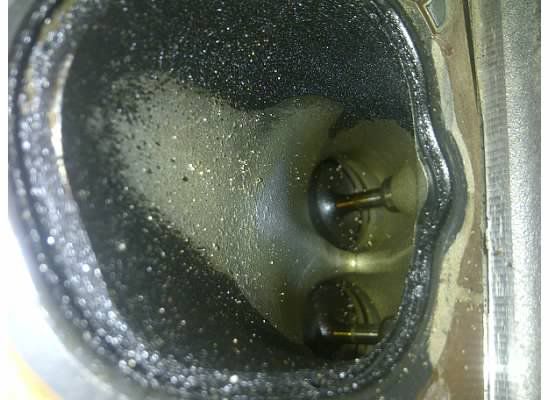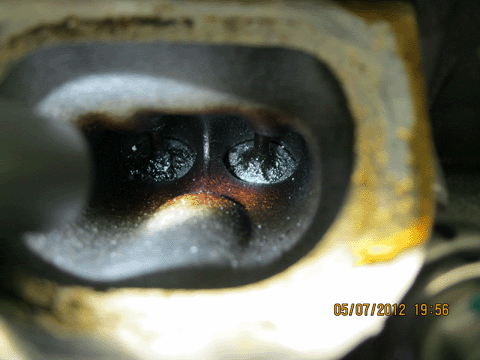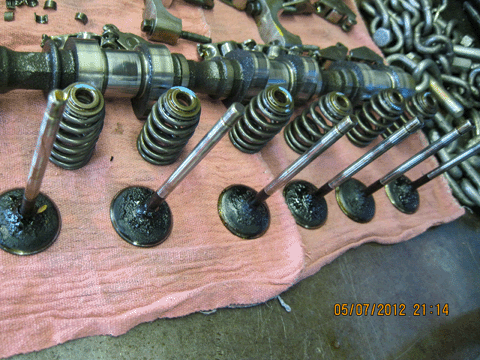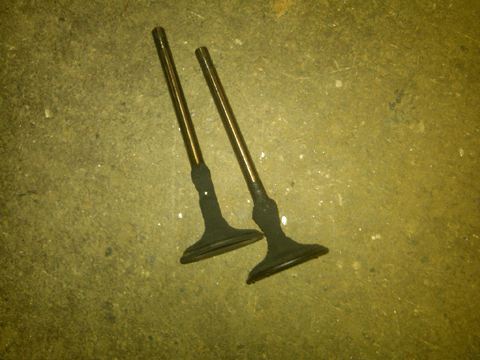LT1 forced induction
#1
Instructor


Thread Starter
Member Since: Dec 2012
Location: Happy Valley OR
Posts: 209
Likes: 0
Received 0 Likes
on
0 Posts
So with an 11:5 compression ratio how is the LT1 going to handle forced induction or can it? I know the LS9 ZR1 is 9:1 because it is supercharged. Any ideas?
#2
I don't know much but the V6 Camaro LLT is 11.4:1, with direct injection, VVT, has 312hp with 6psi of boost it makes 435 or so HP. I think the new LT1 will take 6psi but I have no idea how the computer will do, and how long it will take to hack the pcm. 2 years?
#5
Melting Slicks


The GM tech on ls1tech pretty much stated it would be difficult to crack the ECU Fueling and noid tables. But that the ECU is self adjusting and can change/adjust the tune by itself. Now I take that with a grain of salt but might be the only hope untill the ECU is hacked.
Last edited by JMBLOWNWS6; 12-31-2012 at 02:54 AM.
#7
Team Owner


I agree and since other cars with NA DI have higher compression ratios, I believe the reason for the relatively low compression ratio of 11.5 was selected(along with a forged crank, nodular iron main bearing caps, and piston oil squirter's) was so that a blower could be installed as a factory option, without any engine modifications, to keep the cost down.
#8
Instructor


Thread Starter
Member Since: Dec 2012
Location: Happy Valley OR
Posts: 209
Likes: 0
Received 0 Likes
on
0 Posts
I agree and since other cars with NA DI have higher compression ratios, I believe the reason for the relatively low compression ratio of 11.5 was selected(along with a forged crank, nodular iron main bearing caps, and piston oil squirter's) was so that a blower could be installed as a factory option, without any engine modifications, to keep the cost down.
#9
Racer


Member Since: Sep 2012
Location: Palmetto FL
Posts: 301
Likes: 0
Received 0 Likes
on
0 Posts
St. Jude Donor '13
The direct injection motors can be boosted pretty high as there is far less chance of pre-ignition/detonation.
The LLT & LFX V6 GM motors are 11.3:1 and we boost those anywhere from 6-17#'s of boost and they love it, and here is why.
With a traditional carburated or port injected engine the fuel air mixture enters the cylinder head intake port together. Theis mixture begins to enter the cylinder as soon as the exhaust valve closes and the intake valve opens at the very beginning of the intake stroke (sooner depending on the overlap ground into the cam). The air fuel misture is in the cyliner through the entire intake stroke and also the complete compression stroke so any glowing carbon deposit can and will ignite the mixture before TDC as it compresses. Thus the need for lower compression and higher octaine fuel to prevent this. (the higher the octaine, the less volatile, the more controlled burn and the leass power/engergy produced).
With DI the fuel is introduced into the cylinder directly at between 2-3,000 PSI (depending on the system) and only in the fianl portion of the compression stroke so it is in the chamber only milliseconds thus greatly reducing the chance of detonation.
The results are cleaner more complete combustion, better burn pattern, and more engery produced per explosive event (more power per CI or liter, better fuel economy).
The downside is the intake valve coking because no fuel mixture touches the intake valves and they look like this in no time at all (5-8k miles the volumetric efficiency of the intake port, valve design are already negatively effected) so running a good top tier fuel has zero effect at preventing these deposits. Below is a picture of the 3.6 LY7 non DI motor intake valves/port with over 100k miles running top tier fuel:

Now the same engine but the LLT DI version after only 8k miles:

And at 16k miles:


So, unless the oil ingestion is stopped before entering the intake air charge, this is the result.
But back to boosting the new LT1. At 11.5:1 it will love a reasonable amount of boost.....but there is an entire new problem that arises and that is fuel delivery.
Since the DI engines rely on 2000-3000 plus PSI there are no readily available aftermarket fuel pumps to provide the extra fuel needed to support the new power levels, and the injectors are totally different so no upgrade/higher capacity injectors. Most DI motors the injectors have plenty of capacity, but the HPDI fuel pump (driven off of an extra cam lobe, and watch...in the next few years you will be seeing the pushrods go away and overhead cams will be the standard) only has so much capacity and since it is a piston driven pump (unlike some imports with rotary HPDI pumps that can be modified) power will be limited to the OEM pumps capabilities.
On the DI engines we build now above a certain level we either do a standalone conventional fuel injection system in addition (separate controllers, etc.) or weld and machine an additional boss to allow to HPDI pumps in parrallel.
This and the other next gen of engines (all will be DI within the next 2-3 years) are going to put most tuning shops back at step one in dealing with engine mods.
Luckily the european and import crowd has a head start and we can learn from the solutions they have already come up with, but the pushrod V8 single cam DI motors are completely new ground.
To date, we have pushed the 3.6 DI GM engine to just under 700 hp (V6) and have developed forged pistons and stroker crank, after market cams and proerly ported cylinder heads (another area where traditional porting does not apply as a DI engine flows air only, so loss of velocity from porting to large causes power loss).
Have more questions? Ask & I'll do our best to answer them. The DI engines are unreal.....but so many things are not going to apply as they have in the past....similar to when we moved from the carburated and TB injected engines to port injection and the first gen of the LS series.

The LLT & LFX V6 GM motors are 11.3:1 and we boost those anywhere from 6-17#'s of boost and they love it, and here is why.
With a traditional carburated or port injected engine the fuel air mixture enters the cylinder head intake port together. Theis mixture begins to enter the cylinder as soon as the exhaust valve closes and the intake valve opens at the very beginning of the intake stroke (sooner depending on the overlap ground into the cam). The air fuel misture is in the cyliner through the entire intake stroke and also the complete compression stroke so any glowing carbon deposit can and will ignite the mixture before TDC as it compresses. Thus the need for lower compression and higher octaine fuel to prevent this. (the higher the octaine, the less volatile, the more controlled burn and the leass power/engergy produced).
With DI the fuel is introduced into the cylinder directly at between 2-3,000 PSI (depending on the system) and only in the fianl portion of the compression stroke so it is in the chamber only milliseconds thus greatly reducing the chance of detonation.
The results are cleaner more complete combustion, better burn pattern, and more engery produced per explosive event (more power per CI or liter, better fuel economy).
The downside is the intake valve coking because no fuel mixture touches the intake valves and they look like this in no time at all (5-8k miles the volumetric efficiency of the intake port, valve design are already negatively effected) so running a good top tier fuel has zero effect at preventing these deposits. Below is a picture of the 3.6 LY7 non DI motor intake valves/port with over 100k miles running top tier fuel:

Now the same engine but the LLT DI version after only 8k miles:

And at 16k miles:


So, unless the oil ingestion is stopped before entering the intake air charge, this is the result.
But back to boosting the new LT1. At 11.5:1 it will love a reasonable amount of boost.....but there is an entire new problem that arises and that is fuel delivery.
Since the DI engines rely on 2000-3000 plus PSI there are no readily available aftermarket fuel pumps to provide the extra fuel needed to support the new power levels, and the injectors are totally different so no upgrade/higher capacity injectors. Most DI motors the injectors have plenty of capacity, but the HPDI fuel pump (driven off of an extra cam lobe, and watch...in the next few years you will be seeing the pushrods go away and overhead cams will be the standard) only has so much capacity and since it is a piston driven pump (unlike some imports with rotary HPDI pumps that can be modified) power will be limited to the OEM pumps capabilities.
On the DI engines we build now above a certain level we either do a standalone conventional fuel injection system in addition (separate controllers, etc.) or weld and machine an additional boss to allow to HPDI pumps in parrallel.
This and the other next gen of engines (all will be DI within the next 2-3 years) are going to put most tuning shops back at step one in dealing with engine mods.
Luckily the european and import crowd has a head start and we can learn from the solutions they have already come up with, but the pushrod V8 single cam DI motors are completely new ground.
To date, we have pushed the 3.6 DI GM engine to just under 700 hp (V6) and have developed forged pistons and stroker crank, after market cams and proerly ported cylinder heads (another area where traditional porting does not apply as a DI engine flows air only, so loss of velocity from porting to large causes power loss).
Have more questions? Ask & I'll do our best to answer them. The DI engines are unreal.....but so many things are not going to apply as they have in the past....similar to when we moved from the carburated and TB injected engines to port injection and the first gen of the LS series.

#10
Instructor


Thread Starter
Member Since: Dec 2012
Location: Happy Valley OR
Posts: 209
Likes: 0
Received 0 Likes
on
0 Posts
Rev Xtreme, thanks for your time in typing that out. Very informative. Basically the GOOD news is the DI loves boost as you explained, but the flip side is the tuning part. I was pretty sure the self-tune stuff was wishful thinking. Maybe not on mild bolt on stuff, but if you want to make any serious power, it WILL have to be tuned. No way around it. Give it a year of two, someone will find a way 

#11
Le Mans Master


Member Since: Jul 2009
Location: Los Angeles California
Posts: 9,526
Likes: 0
Received 10 Likes
on
10 Posts
The direct injection motors can be boosted pretty high as there is far less chance of pre-ignition/detonation.
The LLT & LFX V6 GM motors are 11.3:1 and we boost those anywhere from 6-17#'s of boost and they love it, and here is why.
With a traditional carburated or port injected engine the fuel air mixture enters the cylinder head intake port together. Theis mixture begins to enter the cylinder as soon as the exhaust valve closes and the intake valve opens at the very beginning of the intake stroke (sooner depending on the overlap ground into the cam). The air fuel misture is in the cyliner through the entire intake stroke and also the complete compression stroke so any glowing carbon deposit can and will ignite the mixture before TDC as it compresses. Thus the need for lower compression and higher octaine fuel to prevent this. (the higher the octaine, the less volatile, the more controlled burn and the leass power/engergy produced).
With DI the fuel is introduced into the cylinder directly at between 2-3,000 PSI (depending on the system) and only in the fianl portion of the compression stroke so it is in the chamber only milliseconds thus greatly reducing the chance of detonation.
The results are cleaner more complete combustion, better burn pattern, and more engery produced per explosive event (more power per CI or liter, better fuel economy).
The downside is the intake valve coking because no fuel mixture touches the intake valves and they look like this in no time at all (5-8k miles the volumetric efficiency of the intake port, valve design are already negatively effected) so running a good top tier fuel has zero effect at preventing these deposits. Below is a picture of the 3.6 LY7 non DI motor intake valves/port with over 100k miles running top tier fuel:

Now the same engine but the LLT DI version after only 8k miles:

And at 16k miles:


So, unless the oil ingestion is stopped before entering the intake air charge, this is the result.
But back to boosting the new LT1. At 11.5:1 it will love a reasonable amount of boost.....but there is an entire new problem that arises and that is fuel delivery.
Since the DI engines rely on 2000-3000 plus PSI there are no readily available aftermarket fuel pumps to provide the extra fuel needed to support the new power levels, and the injectors are totally different so no upgrade/higher capacity injectors. Most DI motors the injectors have plenty of capacity, but the HPDI fuel pump (driven off of an extra cam lobe, and watch...in the next few years you will be seeing the pushrods go away and overhead cams will be the standard) only has so much capacity and since it is a piston driven pump (unlike some imports with rotary HPDI pumps that can be modified) power will be limited to the OEM pumps capabilities.
On the DI engines we build now above a certain level we either do a standalone conventional fuel injection system in addition (separate controllers, etc.) or weld and machine an additional boss to allow to HPDI pumps in parrallel.
This and the other next gen of engines (all will be DI within the next 2-3 years) are going to put most tuning shops back at step one in dealing with engine mods.
Luckily the european and import crowd has a head start and we can learn from the solutions they have already come up with, but the pushrod V8 single cam DI motors are completely new ground.
To date, we have pushed the 3.6 DI GM engine to just under 700 hp (V6) and have developed forged pistons and stroker crank, after market cams and proerly ported cylinder heads (another area where traditional porting does not apply as a DI engine flows air only, so loss of velocity from porting to large causes power loss).
Have more questions? Ask & I'll do our best to answer them. The DI engines are unreal.....but so many things are not going to apply as they have in the past....similar to when we moved from the carburated and TB injected engines to port injection and the first gen of the LS series.

The LLT & LFX V6 GM motors are 11.3:1 and we boost those anywhere from 6-17#'s of boost and they love it, and here is why.
With a traditional carburated or port injected engine the fuel air mixture enters the cylinder head intake port together. Theis mixture begins to enter the cylinder as soon as the exhaust valve closes and the intake valve opens at the very beginning of the intake stroke (sooner depending on the overlap ground into the cam). The air fuel misture is in the cyliner through the entire intake stroke and also the complete compression stroke so any glowing carbon deposit can and will ignite the mixture before TDC as it compresses. Thus the need for lower compression and higher octaine fuel to prevent this. (the higher the octaine, the less volatile, the more controlled burn and the leass power/engergy produced).
With DI the fuel is introduced into the cylinder directly at between 2-3,000 PSI (depending on the system) and only in the fianl portion of the compression stroke so it is in the chamber only milliseconds thus greatly reducing the chance of detonation.
The results are cleaner more complete combustion, better burn pattern, and more engery produced per explosive event (more power per CI or liter, better fuel economy).
The downside is the intake valve coking because no fuel mixture touches the intake valves and they look like this in no time at all (5-8k miles the volumetric efficiency of the intake port, valve design are already negatively effected) so running a good top tier fuel has zero effect at preventing these deposits. Below is a picture of the 3.6 LY7 non DI motor intake valves/port with over 100k miles running top tier fuel:

Now the same engine but the LLT DI version after only 8k miles:

And at 16k miles:


So, unless the oil ingestion is stopped before entering the intake air charge, this is the result.
But back to boosting the new LT1. At 11.5:1 it will love a reasonable amount of boost.....but there is an entire new problem that arises and that is fuel delivery.
Since the DI engines rely on 2000-3000 plus PSI there are no readily available aftermarket fuel pumps to provide the extra fuel needed to support the new power levels, and the injectors are totally different so no upgrade/higher capacity injectors. Most DI motors the injectors have plenty of capacity, but the HPDI fuel pump (driven off of an extra cam lobe, and watch...in the next few years you will be seeing the pushrods go away and overhead cams will be the standard) only has so much capacity and since it is a piston driven pump (unlike some imports with rotary HPDI pumps that can be modified) power will be limited to the OEM pumps capabilities.
On the DI engines we build now above a certain level we either do a standalone conventional fuel injection system in addition (separate controllers, etc.) or weld and machine an additional boss to allow to HPDI pumps in parrallel.
This and the other next gen of engines (all will be DI within the next 2-3 years) are going to put most tuning shops back at step one in dealing with engine mods.
Luckily the european and import crowd has a head start and we can learn from the solutions they have already come up with, but the pushrod V8 single cam DI motors are completely new ground.
To date, we have pushed the 3.6 DI GM engine to just under 700 hp (V6) and have developed forged pistons and stroker crank, after market cams and proerly ported cylinder heads (another area where traditional porting does not apply as a DI engine flows air only, so loss of velocity from porting to large causes power loss).
Have more questions? Ask & I'll do our best to answer them. The DI engines are unreal.....but so many things are not going to apply as they have in the past....similar to when we moved from the carburated and TB injected engines to port injection and the first gen of the LS series.

BTW, apparently the fuel system on the LT1 is good to handle just over 1000 HP. Should be fine for basic boosting. Probably won't be good for anything over 1 bar.
#12
Team Owner


#14
Read about Mazda's Skyactiv engines. US market versions are running 13:1 on regular gasoline and overseas versions run 14:1 on premium. I'm honestly suprised GM didn't go 12:1 or higher with the LT1.
#15
Le Mans Master


#16
Le Mans Master


The GM tech on ls1tech pretty much stated it would be difficult to crack the ECU Fueling and noid tables. But that the ECU is self adjusting and can change/adjust the tune by itself. Now I take that with a grain of salt but might be the only hope untill the ECU is hacked.
#17
Melting Slicks


It ain't over til' it's over. Respect the techs but they were saying the same thing about the C6 ZR1 "locked" from the factory and people should just get used to it. I'm always amazed at the aftermarket's ability to find a way. Nothing is uncrackable when it comes to automotive electronics.

#20
Le Mans Master


1000 HP on stock DI? Wish that to be true but why would the engineers design that robust? Sorry not likely. The big issue will be injector timing and aftermarket injectors. Look at large tuners for 997.1 vrs 997.2
personally until these issues are hammered out fi will be out unless your OK with a hacked additional Injection or alky Injection.
personally until these issues are hammered out fi will be out unless your OK with a hacked additional Injection or alky Injection.






